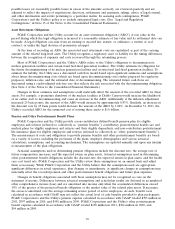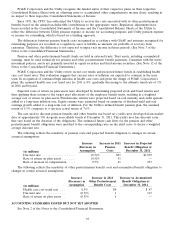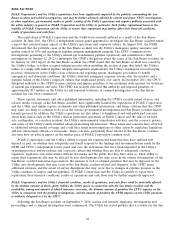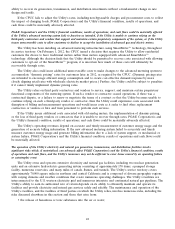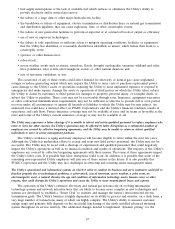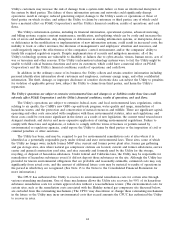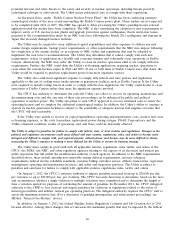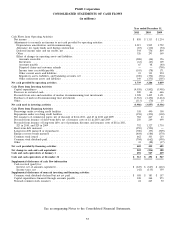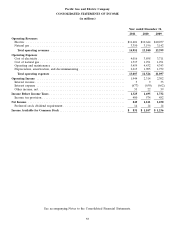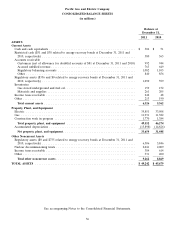PG&E 2011 Annual Report Download - page 50
Download and view the complete annual report
Please find page 50 of the 2011 PG&E annual report below. You can navigate through the pages in the report by either clicking on the pages listed below, or by using the keyword search tool below to find specific information within the annual report.potential terrorist and other threats to the safety and security of nuclear operations, including threats posed by
radiological sabotage or cyber-attack. The Utility incurs substantial costs to comply with these regulations.
As discussed above, under ‘‘Diablo Canyon Nuclear Power Plant,’’ the Utility has been conducting extensive
seismological studies of the area at and surrounding the Diablo Canyon power plant. These studies are not expected
to be completed until 2014 or 2015. The NRC has agreed to delay processing the Utility’s pending license renewal
application until the studies have been completed. The NRC is also considering the adoption of new requirements to
improve safety at U.S. nuclear power plants and upgrade protection against earthquakes, floods and power losses,
pursuant to the recommendations made by an NRC task force following the March 2011 earthquake and tsunami in
Japan that seriously damaged nuclear facilities.
The Utility may be required to incur additional capital expenditures and other expenses to address any new
seismic design requirements, backup power requirements, or other requirements that the NRC may impose following
the completion of the seismic studies, or in response to NRC orders and regulations that may be adopted to
implement the task force’s recommendations. The Utility may determine that it cannot comply with such new
requirements, orders or regulations in a feasible and economic manner and voluntarily cease operations at Diablo
Canyon. Alternatively, the NRC may order the Utility to cease its nuclear operations until it can comply with new
requirements. Further, the NRC could deny the Utility’s re-licensing applications requiring nuclear operations to
cease when the current licenses expire in 2024 and 2025. If one or both units at Diablo Canyon were shut down, the
Utility would be required to purchase replacement power from more expensive sources.
The Utility also could incur significant expense to comply with federal and state policies and regulations
applicable to the use of cooling water intake systems at generation facilities, such as Diablo Canyon. If the Utility
were required to install cooling towers in order to comply with the new regulations, the Utility could decide to cease
operations at Diablo Canyon rather than incur the significant expense involved.
The CPUC has authority to determine the rates the Utility can collect to recover its operating, maintenance and
decommissioning costs and the outcome of these rate proceedings can be influenced by public and political
opposition to nuclear power. The Utility also plans to seek CPUC approval to recover estimated costs to renew the
operating licenses and to complete the additional seismological studies. In addition, the Utility’s ability to continue to
operate its nuclear generation facilities is subject to the availability of adequate nuclear fuel supplies on terms that
the CPUC will find reasonable.
If the Utility were unable to recover its capital expenditures, operating and maintenance costs, nuclear fuel costs,
re-licensing expenses, or the costs to purchase replacement power during outages, PG&E Corporation’s and the
Utility’s financial condition, results of operations, and cash flows could be materially affected.
The Utility is subject to penalties for failure to comply with federal, state, or local statutes and regulations. Changes in the
political and regulatory environment could cause federal and state statutes, regulations, rules, and orders to become more
stringent and difficult to comply with, and required permits, authorizations, and licenses may be more difficult to obtain,
increasing the Utility’s expenses or making it more difficult for the Utility to execute its business strategy.
The Utility must comply in good faith with all applicable statutes, regulations, rules, tariffs, and orders of the
CPUC, the FERC, the NRC, and other regulatory agencies relating to the aspects of its electricity and natural gas
utility operations that fall within the jurisdictional authority of such agencies. In addition to the NRC requirements
described above, these include meeting new renewable energy delivery requirements, resource adequacy
requirements, federal electric reliability standards, customer billing, customer service, affiliate transactions, vegetation
management, operating and maintenance practices, and safety and inspection practices. The Utility is subject to
penalties and sanctions for failure to comply with applicable statutes, regulations, rules, tariffs, and orders.
On January 1, 2012, the CPUC’s statutory authority to impose penalties increased from up to $20,000 per day,
per violation, to up to $50,000 per day, per violation. The CPUC has wide discretion to determine, based on the facts
and circumstances, whether a single violation or multiple violations were committed and to determine the length of
time a violation existed for purposes of calculating the amount of penalties. In December 2011, the CPUC delegated
authority to the CPSD to levy citations and impose penalties for violations of regulations related to the safety of
natural gas facilities and utilities’ natural gas operating practices. The delegated authority requires the CPUC staff to
assess the maximum statutory fine. (For a discussion of pending investigations and enforcement proceedings, see
MD&A ‘‘Natural Gas Matters’’ above.)
In addition, on January 3, 2012, the federal Pipeline Safety, Regulatory Certainty and Job Creation Act of 2011
became effective. Among other changes, this act increases the maximum penalty that may be imposed by the federal
46


